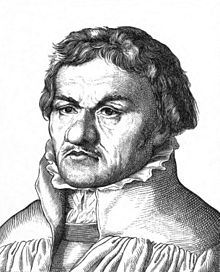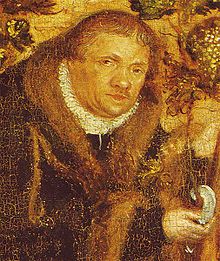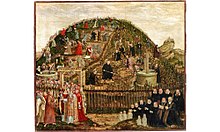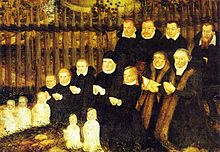Paul Eber

Paul Eber (born November 8, 1511 in Kitzingen , † December 10, 1569 in Wittenberg ) was a Protestant theologian , hymn poet and reformer .
Life
Paul Eber was born the son of a tailor named Johann († May 23, 1534 in Wittenberg) and his wife Magarethe Pfleumin in Kitzingen in what is now Falterstrasse. He received his training at the home school in Kitzingen and in 1523 moved to the Latin school in Ansbach . At the age of 13 he was thrown from a continuous horse and dragged along for half an hour. Since that accident he has always remained a little crooked. Due to his talent, however, he was encouraged and supported, so that from 1525 he was a student of Johann Ketzmann at the Lorenz School and was able to attend the then Agidiengymnasium in Nuremberg .
On June 1, 1532 he enrolled at the University of Wittenberg , where he caught the attention of Philipp Melanchthon , was promoted by him and remained connected to him throughout his life. That is why it was called the "Respectorium Philippi" . In Wittenberg he obtained his master's degree in philosophy on April 27, 1536 and was accepted into the senate of the philosophical faculty in April 1537. From now on he started teaching himself. His repetitions and disputations in philosophy, physics and the old authors attracted more and more students, so that on July 11, 1541 he was given the professorship of the Latin language from Elector Johann Friedrich as a permanent position .
As a result of an electoral rescript dated December 30, 1543, the Kitzingen scholar received the professorship for physics previously held by Veit Amerbach . In the summer semester of 1544 Eber became professor of Latin grammar and entered the academic senate of the University of Wittenberg. The work at the Wittenberg Academy, which had been interrupted by the consequences of the Schmalkaldic War , was resumed by the boar, who had remained in Wittenberg, in the winter semester of 1547. In 1550 he became dean of the philosophical faculty.
He was already involved in church affairs at an early stage. You can find it at the convent in Pegau, in numerous entries of church visits by the Saxon spa districts in 1555 and at the colloquium in Worms (1557). When he took over the completed offices of the late Johann Forster on April 26, 1557 , he received the chair for the Hebrew language and the position of chief preacher at the Wittenberg Castle Church . After the death of Johannes Bugenhagen on April 20, 1558, he took over his position as general superintendent of the Saxon spa district and thus became senior pastor at the Wittenberg town church.
As pastor of the mother church of the Reformation , he became professor of theology and general superintendent. In recognition of his services, he received his doctorate in theology in 1559. After the death of Philipp Melanchthon in 1560, he became a member of the theological faculty and was from this time the most important figure in the Protestant Church at the center of the Reformation, where he continued to take Melanchthon's mediator position in a time of intensifying dogmatic contradictions. He knew how to convey Martin Luther's intentions and was therefore able to mediate in the disputes between the Gnesiolutherans and the cryptocalvinists . He also worked for the university as rector in the winter semester of 1551 and in the equivalent prorectorate in the summer semester of 1557.
His deep religiosity is expressed in his hymns, which made him the most important poet alongside Luther at the center of the Reformation. After a busy life in the Protestant church, Paul Eber died in Wittenberg. He was buried in the Wittenberg town church. Wealthy citizens donated an epitaph in his memory. This by Lucas Cranach the Elder J. designed epitaph, The Lord's Vineyard , is still one of the most important works in the Wittenberg town church .
family
Regarding his family circumstances, it should be mentioned that Paul Eber, on September 13, 1541 in Leipzig, Helene (* 1523 in Nuremberg; † July 22, 1569 in Wittenberg), daughter of the Nuremberg goldsmith Günther Kuffner and his wife Margarethe NN († February 24, 1563 in Wittenberg) married. This marriage resulted in 13 children, 5 of which died in childhood before Paul Eber (two girls and three boys). Another two girls and six boys survived their father. His entire family is depicted in the epitaph Paul Ebers. The children who have already died are depicted as people dressed in white, corresponding to the time, with the boys standing to the right of Paul Eber holding a prayer book and the girls positioning themselves to his left. His son-in-law Johann Leupold is also pictured behind the family on the right. The following are known of his children:
- Paul Eber II. (Born November 22, 1542 in Wittenberg; † February 9, 1572 in Wittenberg), after studying at the University of Wittenberg (November 24, 1551 matriculated), became a master's degree on March 4, 1561 and rector of the Wittenberg city school in 1567 ordered. He made a name for himself as a hymn poet, married on October 16, 1564 Maria Major († October 18, 1569 in Wittenberg) with whom he had the daughter Theodora (born December 19, 1566 in Wittenberg; † April 12, 1569 ibid). On September 18, 1570 he was married again to Magarethe, daughter of Burchard Matthies. This marriage remained childless; the widow married after Paul Ebers II death, on November 1, 1575 the Magister Johann Kraus.
- Maria (born July 17, 1562 in Wittenberg)
- Timothy († January 30, 1564 in Wittenberg)
- Helene, marries Magister Johann Leupold from Zwickau on February 25, 1566 in Wittenberg
- Johannes (* 1550 in Wittenberg, matriculated on August 10, 1557 † December 8, 1580 as a deacon in Kitzingen) married Katharina Schmidt from Ansbach on September 10, 1576 in Wittenberg
- Martin (enrolled for free in May 1579)
- Melchior (matriculated 10 August 1557)
- an unnamed daughter died before December 29, 1547
Works
Fonts
- "Contexta populi Judaici historia a reditu ex Babylonico exilio usque ad ultimum excidium Hierosolymae", Wittenberg 1548 (many editions, translated into German and French);
- “Calendarium historicum”, Wittenberg 1550 (many editions, translated into German and French);
- "Evangeliorum dominicalium explicatio", edited by Johann Cellarius, Frankfurt 1576 (German edition, Frankfurt 1578);
- "Catechism Sermons", edited by Theophilus Feurelius, Nuremberg 1577;
- “Of the holy sacrament of the body and Blood of our Lord Jesus Christ ”, Wittenberg 1562;
- "Pia assertio de coena domini", Wittenberg 1563;
- "Biblia germanico-latina", as an employee in Wittenberg 1565;
- "Letters in the Ccrp.Ref. 3-9 “are in the Staatsbibl. Munich u. Research library Gotha
- "Biblia Germanico-Latina", Wittenberg 1565, the Old Testament for the great biblical work of the Elector August von Sachsen with Georg Major
- "Pia assertio de coena domini", 1563.
- “Explanation of the definition or description of God” published by Mattheus Major in 1588
- "Writings on the Sacrament Question"
- "Psalterium cum argumentis" 1563
Songs
- "Help me praise God's goodness" ( EKG 37)
- "Lord Jesus Christ, true man and God" (EKG 314)
- "When we are in dire straits" ( EG 366)
- “Lord God, we all praise you” (EKG 115); With this text the Geneva melody for the 134th Psalm became at home in Lutheran Germany.
- "I fall asleep in Jesus' wounds"
- "Two things, oh Lord, I ask of you"
literature
- Daniel Gehren and Volker Leppin (eds.): Paul Eber (1511–1569). Humanist and theologian of the second generation of the Wittenberg Reformation, Leipzig 2014.
- Nikolaus Müller : The finds in the tower knobs at Wittenberg , Magdeburg 1912
- Albrecht Steinwachs: The Lord's Vineyard , at Edition Akanthius, Spröda, 2001 ISBN 3-00-008905-5 (German) ISBN 3-00-008904-7 (English)
- Walther Killy : Literature Lexicon. Authors and works in German (15 volumes). Gütersloh, Munich: Bertelsmann-Lexikon-Verl., 1988–1991 (CD-ROM: Berlin 1998, ISBN 3-932544-13-7 ).
- Balthasa Mencii: Historica Narratio de Septem Electoribus ..., Frankfurt / Main 1577
- Heinz Kathe : The Wittenberg Philosophical Faculty 1502–1817 (= Central German Research. Volume 117). Böhlau, Cologne / Weimar / Vienna 2002, ISBN 3-412-04402-4 .
- Walter Friedensburg : History of the University of Wittenberg , Max Niemeyer, Halle (Saale) 1917,
- Heinz Scheible, Corinna Schneider: Melanchthons Briefwechsel (MBW) Volume 11: People AE, Verlag Frommann-Holzboog, 2003
- Theodor Pressel: Paul Eber: According to simultaneous sources, RL Friderichs, 1862
- Heinrich Eduard Schmieder : Paul Eber ; In: Ferdinand Piper : The witnesses of truth - images of life for the evangelical calendar for all years of the day. Publishing house by Bernahard Tauschnitz, Leipzig 1874 3rd vol. Pp. 383–388
- Wolfgang Klose: The Wittenberg Scholar's Studbook: the studbook of Abraham Ulrich (1549-1577) and David Ulrich (1580-1623). Medium Verlag, Halle (Saale) 1999, ISBN 3-932776-76-3
- Georg Buchwald : Dr. Paul Eber, the friend, collaborator and successor of the reformers. A picture of his life and work, Leipzig 1897.
- Adolf Brecher: Eber, Paul . In: Allgemeine Deutsche Biographie (ADB). Volume 5, Duncker & Humblot, Leipzig 1877, pp. 529-531.
- Robert Stupperich : Eber, Paul. In: New German Biography (NDB). Volume 4, Duncker & Humblot, Berlin 1959, ISBN 3-428-00185-0 , p. 225 ( digitized version ).
- Gustav Kawerau: Eber, Paul . In: Realencyklopadie for Protestant Theology and Church (RE). 3. Edition. Volume 5, Hinrichs, Leipzig 1898, pp. 118-121.
- Friedrich Wilhelm Bautz : Eber, Paul. In: Biographisch-Bibliographisches Kirchenlexikon (BBKL). Volume 1, Bautz, Hamm 1975. 2nd, unchanged edition Hamm 1990, ISBN 3-88309-013-1 , Sp. 1441-1442.
Web links
| personal data | |
|---|---|
| SURNAME | Eber, Paul |
| ALTERNATIVE NAMES | Eberus Paulus; Ebert, Paul |
| BRIEF DESCRIPTION | German theologian, hymn poet and reformer |
| DATE OF BIRTH | November 8, 1511 |
| PLACE OF BIRTH | Kitzingen |
| DATE OF DEATH | December 10, 1569 |
| Place of death | Wittenberg |



